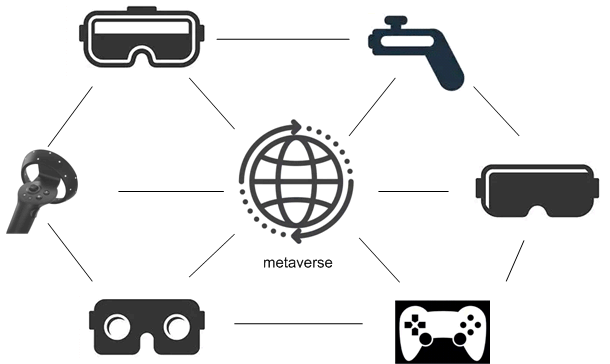Content for TR 22.856 Word version: 19.2.0
1…
5…
5.2…
5.3…
5.4…
5.5…
5.6…
5.7…
5.8…
5.9…
5.10…
5.11…
5.12…
5.13…
5.14…
5.15…
5.16…
5.17…
5.18…
5.19…
5.20…
5.21…
5.22…
5.23…
5.24…
5.25…
5.26…
5.27…
5.28…
6
7…
7.2
8
A
B
C…
5.8 Use Case on multi-service coordination in one mobile metaverse service
5.8.1 Description
5.8.2 Pre-conditions
5.8.3 Service Flows
5.8.4 Post-conditions
5.8.5 Existing features partly or fully covering the use case functionality
5.8.6 Potential New Requirements needed to support the use case
...
...
5.8 Use Case on multi-service coordination in one mobile metaverse service p. 39
5.8.1 Description p. 39
There's a major difference between a metaverse service and traditional multi-media service. A mobile metaverse service provides a platform which supports different applications to complete a task such as gaming, online-working, online-education, etc. Users will have no limitations on the terminals they use. In existing XR applications, specific brand of VR glasses or gloves are required to be used in a game, different brands of VR glasses and gloves will be very hard to map and coordinate in a same game. But in mobile metaverse services, the nature of the standard will support the coordination between different equipment belonging to different applications or brands.

Figure 5.8.1-1: multi-service coordination in one mobile metaverse service
(⇒ copy of original 3GPP image)
(⇒ copy of original 3GPP image)
5.8.2 Pre-conditions p. 40
John has a pair of VR glasses and a pair of tactile gloves. Usually, he uses VR glasses for VR games and tactile gloves for vertical painting where he can feel the brushstrokes. These two activities were running on two different network slices. As the VR glasses was bought to play VR games, the VR game application has a network slice A which is better support the game service. Tactile gloves belong to Brand B which has another network slice B.
In the mobile metaverse, there are many different types of services such as games, concerts, education, etc. And the mobile metaverse services has subscribed different network slice for these different types of service, and different QoS for different flows accordingly for better user experience.
5.8.3 Service Flows p. 40
- John opens a mobile metaverse service, in which both VR glasses and tactile gloves are needed, and he would like to draw a picture with tactile gloves and see a live music show at the same time.
- In the subscription between mobile metaverse service (which can be hosted by operators or other companies) and network, the video flow, audio flow in live music condition were subscribes to QoS 1 and QoS2 in slice A, the video flow and tactile flow in painting condition were subscribes to QoS 3 and QoS4 in slice B in art painting.
- In John's VR glasses he can see the singer and other listeners and at the same time. At the same time, he can see his painting on a virtual easel and use a virtual brush to paint, while he can feel the brushstrokes with the tactile feedback.
- In this case, the mobile metaverse service will have a policy to use a same QoS level for the video flows in live music condition and painting condition and inform network on this decision.
- As John is painting and enjoying the live show at the same time, the coordination between video flow, audio flow in live music mobile metaverse service and the video flow and tactile flow in painting mobile metaverse service need to be coordinated. This coordination information need to be share with the network for policy modification.
- Network will do this dynamic policy modification for John.
5.8.4 Post-conditions p. 40
John used both the VR glasses and the tactile gloves in distinct mobile metaverse services with very good user combined experience.
5.8.5 Existing features partly or fully covering the use case functionality p. 41
The 5G system can support different communication performance policies for services and provides some support for resolving conflicts between the policies of different services.
There is however no way to for the 5G system to coordinate the communication performance delivered so that divergence in communication performance is reduced for distinct services (i.e. from different service providers).
Clause 4.3.1 of TS 23.503 includes the following general requirement "The PCC framework shall allow the resolution of conflicts which would otherwise cause a subscriber's Subscribed Guaranteed Bandwidth QoS to be exceeded.".
Clause 6.1.3.7 of TS 23.503 explains that "Service pre-emption priority enables the PCF to resolve conflicts where the activation of all requested active PCC rules for services would result in a cumulative authorized QoS which exceeds the Subscribed Guaranteed bandwidth QoS.".
5.8.6 Potential New Requirements needed to support the use case p. 41
[PR 5.8.6-1]
The 5G system shall provide the capability of reducing the differences between different mobile metaverse services communication performance for a given UE to prevent inconsistency of experience due to XR media with divergent or conflicting characteristics, e.g., resolution, latency or packet loss.